Sören Pirk
Prompt Pirates Need a Map: Stealing Seeds helps Stealing Prompts
Sep 11, 2025Abstract:Diffusion models have significantly advanced text-to-image generation, enabling the creation of highly realistic images conditioned on textual prompts and seeds. Given the considerable intellectual and economic value embedded in such prompts, prompt theft poses a critical security and privacy concern. In this paper, we investigate prompt-stealing attacks targeting diffusion models. We reveal that numerical optimization-based prompt recovery methods are fundamentally limited as they do not account for the initial random noise used during image generation. We identify and exploit a noise-generation vulnerability (CWE-339), prevalent in major image-generation frameworks, originating from PyTorch's restriction of seed values to a range of $2^{32}$ when generating the initial random noise on CPUs. Through a large-scale empirical analysis conducted on images shared via the popular platform CivitAI, we demonstrate that approximately 95% of these images' seed values can be effectively brute-forced in 140 minutes per seed using our seed-recovery tool, SeedSnitch. Leveraging the recovered seed, we propose PromptPirate, a genetic algorithm-based optimization method explicitly designed for prompt stealing. PromptPirate surpasses state-of-the-art methods, i.e., PromptStealer, P2HP, and CLIP-Interrogator, achieving an 8-11% improvement in LPIPS similarity. Furthermore, we introduce straightforward and effective countermeasures that render seed stealing, and thus optimization-based prompt stealing, ineffective. We have disclosed our findings responsibly and initiated coordinated mitigation efforts with the developers to address this critical vulnerability.
Perm: A Parametric Representation for Multi-Style 3D Hair Modeling
Jul 31, 2024Abstract:We present Perm, a learned parametric model of human 3D hair designed to facilitate various hair-related applications. Unlike previous work that jointly models the global hair shape and local strand details, we propose to disentangle them using a PCA-based strand representation in the frequency domain, thereby allowing more precise editing and output control. Specifically, we leverage our strand representation to fit and decompose hair geometry textures into low- to high-frequency hair structures. These decomposed textures are later parameterized with different generative models, emulating common stages in the hair modeling process. We conduct extensive experiments to validate the architecture design of \textsc{Perm}, and finally deploy the trained model as a generic prior to solve task-agnostic problems, further showcasing its flexibility and superiority in tasks such as 3D hair parameterization, hairstyle interpolation, single-view hair reconstruction, and hair-conditioned image generation. Our code and data will be available at: https://github.com/c-he/perm.
\textsc{Perm}: A Parametric Representation for Multi-Style 3D Hair Modeling
Jul 28, 2024Abstract:We present \textsc{Perm}, a learned parametric model of human 3D hair designed to facilitate various hair-related applications. Unlike previous work that jointly models the global hair shape and local strand details, we propose to disentangle them using a PCA-based strand representation in the frequency domain, thereby allowing more precise editing and output control. Specifically, we leverage our strand representation to fit and decompose hair geometry textures into low- to high-frequency hair structures. These decomposed textures are later parameterized with different generative models, emulating common stages in the hair modeling process. We conduct extensive experiments to validate the architecture design of \textsc{Perm}, and finally deploy the trained model as a generic prior to solve task-agnostic problems, further showcasing its flexibility and superiority in tasks such as 3D hair parameterization, hairstyle interpolation, single-view hair reconstruction, and hair-conditioned image generation. Our code and data will be available at: \url{https://github.com/c-he/perm}.
LRM-Zero: Training Large Reconstruction Models with Synthesized Data
Jun 13, 2024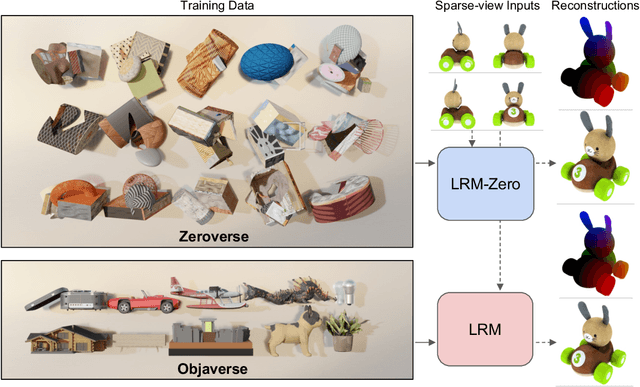

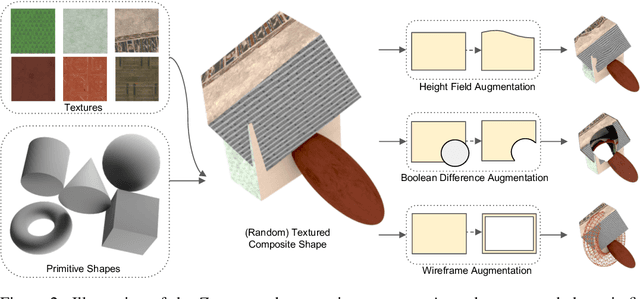

Abstract:We present LRM-Zero, a Large Reconstruction Model (LRM) trained entirely on synthesized 3D data, achieving high-quality sparse-view 3D reconstruction. The core of LRM-Zero is our procedural 3D dataset, Zeroverse, which is automatically synthesized from simple primitive shapes with random texturing and augmentations (e.g., height fields, boolean differences, and wireframes). Unlike previous 3D datasets (e.g., Objaverse) which are often captured or crafted by humans to approximate real 3D data, Zeroverse completely ignores realistic global semantics but is rich in complex geometric and texture details that are locally similar to or even more intricate than real objects. We demonstrate that our LRM-Zero, trained with our fully synthesized Zeroverse, can achieve high visual quality in the reconstruction of real-world objects, competitive with models trained on Objaverse. We also analyze several critical design choices of Zeroverse that contribute to LRM-Zero's capability and training stability. Our work demonstrates that 3D reconstruction, one of the core tasks in 3D vision, can potentially be addressed without the semantics of real-world objects. The Zeroverse's procedural synthesis code and interactive visualization are available at: https://desaixie.github.io/lrm-zero/.
LAESI: Leaf Area Estimation with Synthetic Imagery
Mar 31, 2024Abstract:We introduce LAESI, a Synthetic Leaf Dataset of 100,000 synthetic leaf images on millimeter paper, each with semantic masks and surface area labels. This dataset provides a resource for leaf morphology analysis primarily aimed at beech and oak leaves. We evaluate the applicability of the dataset by training machine learning models for leaf surface area prediction and semantic segmentation, using real images for validation. Our validation shows that these models can be trained to predict leaf surface area with a relative error not greater than an average human annotator. LAESI also provides an efficient framework based on 3D procedural models and generative AI for the large-scale, controllable generation of data with potential further applications in agriculture and biology. We evaluate the inclusion of generative AI in our procedural data generation pipeline and show how data filtering based on annotation consistency results in datasets which allow training the highest performing vision models.
Generating Diverse Agricultural Data for Vision-Based Farming Applications
Mar 27, 2024



Abstract:We present a specialized procedural model for generating synthetic agricultural scenes, focusing on soybean crops, along with various weeds. This model is capable of simulating distinct growth stages of these plants, diverse soil conditions, and randomized field arrangements under varying lighting conditions. The integration of real-world textures and environmental factors into the procedural generation process enhances the photorealism and applicability of the synthetic data. Our dataset includes 12,000 images with semantic labels, offering a comprehensive resource for computer vision tasks in precision agriculture, such as semantic segmentation for autonomous weed control. We validate our model's effectiveness by comparing the synthetic data against real agricultural images, demonstrating its potential to significantly augment training data for machine learning models in agriculture. This approach not only provides a cost-effective solution for generating high-quality, diverse data but also addresses specific needs in agricultural vision tasks that are not fully covered by general-purpose models.
A Lennard-Jones Layer for Distribution Normalization
Feb 05, 2024Abstract:We introduce the Lennard-Jones layer (LJL) for the equalization of the density of 2D and 3D point clouds through systematically rearranging points without destroying their overall structure (distribution normalization). LJL simulates a dissipative process of repulsive and weakly attractive interactions between individual points by considering the nearest neighbor of each point at a given moment in time. This pushes the particles into a potential valley, reaching a well-defined stable configuration that approximates an equidistant sampling after the stabilization process. We apply LJLs to redistribute randomly generated point clouds into a randomized uniform distribution. Moreover, LJLs are embedded in the generation process of point cloud networks by adding them at later stages of the inference process. The improvements in 3D point cloud generation utilizing LJLs are evaluated qualitatively and quantitatively. Finally, we apply LJLs to improve the point distribution of a score-based 3D point cloud denoising network. In general, we demonstrate that LJLs are effective for distribution normalization which can be applied at negligible cost without retraining the given neural network.
Gazebo Plants: Simulating Plant-Robot Interaction with Cosserat Rods
Feb 04, 2024Abstract:Robotic harvesting has the potential to positively impact agricultural productivity, reduce costs, improve food quality, enhance sustainability, and to address labor shortage. In the rapidly advancing field of agricultural robotics, the necessity of training robots in a virtual environment has become essential. Generating training data to automatize the underlying computer vision tasks such as image segmentation, object detection and classification, also heavily relies on such virtual environments as synthetic data is often required to overcome the shortage and lack of variety of real data sets. However, physics engines commonly employed within the robotics community, such as ODE, Simbody, Bullet, and DART, primarily support motion and collision interaction of rigid bodies. This inherent limitation hinders experimentation and progress in handling non-rigid objects such as plants and crops. In this contribution, we present a plugin for the Gazebo simulation platform based on Cosserat rods to model plant motion. It enables the simulation of plants and their interaction with the environment. We demonstrate that, using our plugin, users can conduct harvesting simulations in Gazebo by simulating a robotic arm picking fruits and achieve results comparable to real-world experiments.
Carve3D: Improving Multi-view Reconstruction Consistency for Diffusion Models with RL Finetuning
Dec 21, 2023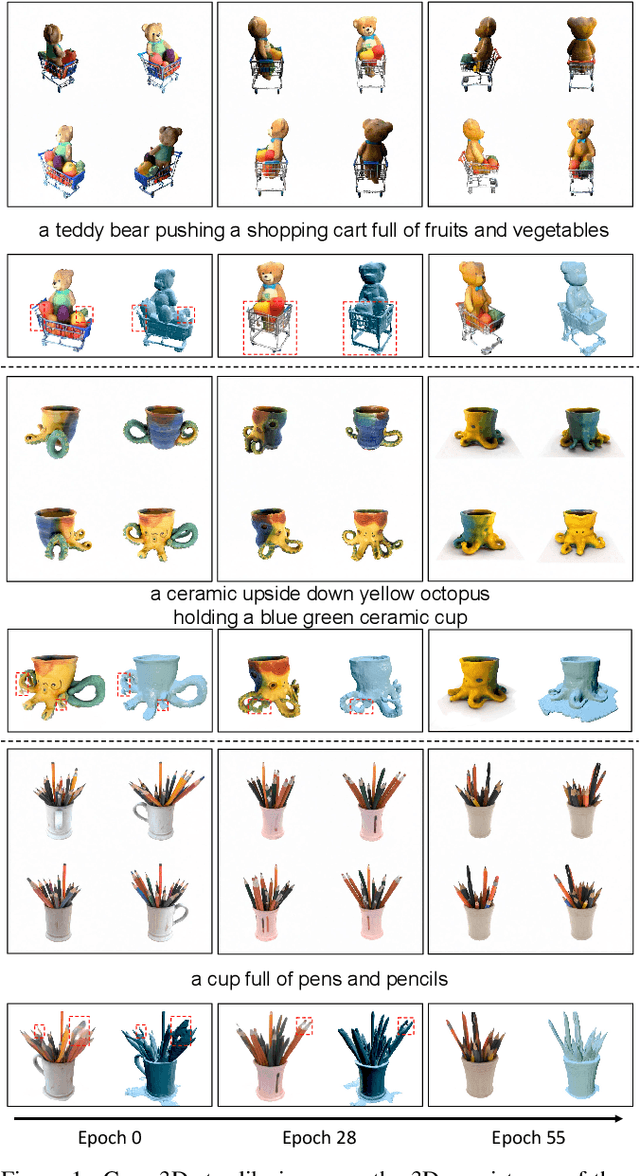
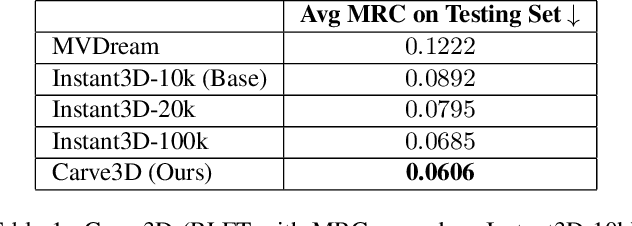
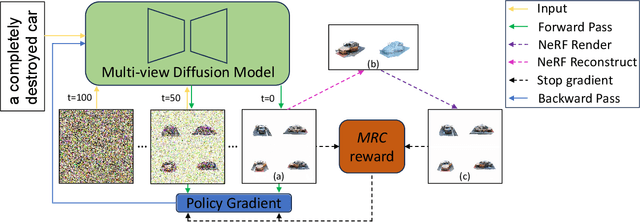
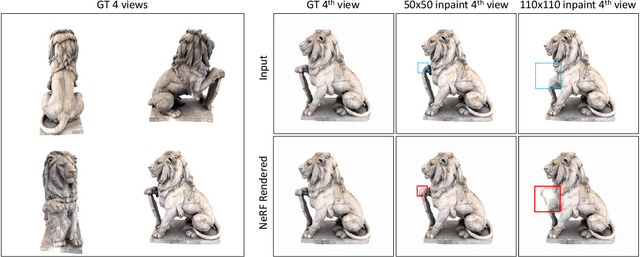
Abstract:Recent advancements in the text-to-3D task leverage finetuned text-to-image diffusion models to generate multi-view images, followed by NeRF reconstruction. Yet, existing supervised finetuned (SFT) diffusion models still suffer from multi-view inconsistency and the resulting NeRF artifacts. Although training longer with SFT improves consistency, it also causes distribution shift, which reduces diversity and realistic details. We argue that the SFT of multi-view diffusion models resembles the instruction finetuning stage of the LLM alignment pipeline and can benefit from RL finetuning (RLFT) methods. Essentially, RLFT methods optimize models beyond their SFT data distribution by using their own outputs, effectively mitigating distribution shift. To this end, we introduce Carve3D, a RLFT method coupled with the Multi-view Reconstruction Consistency (MRC) metric, to improve the consistency of multi-view diffusion models. To compute MRC on a set of multi-view images, we compare them with their corresponding renderings of the reconstructed NeRF at the same viewpoints. We validate the robustness of MRC with extensive experiments conducted under controlled inconsistency levels. We enhance the base RLFT algorithm to stabilize the training process, reduce distribution shift, and identify scaling laws. Through qualitative and quantitative experiments, along with a user study, we demonstrate Carve3D's improved multi-view consistency, the resulting superior NeRF reconstruction quality, and minimal distribution shift compared to longer SFT. Project webpage: https://desaixie.github.io/carve-3d.
DeepTree: Modeling Trees with Situated Latents
May 09, 2023
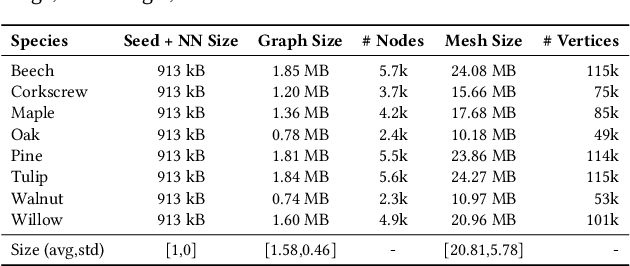

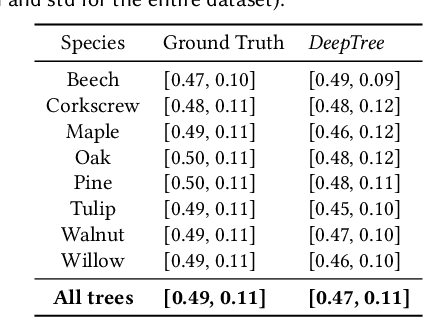
Abstract:In this paper, we propose DeepTree, a novel method for modeling trees based on learning developmental rules for branching structures instead of manually defining them. We call our deep neural model situated latent because its behavior is determined by the intrinsic state -- encoded as a latent space of a deep neural model -- and by the extrinsic (environmental) data that is situated as the location in the 3D space and on the tree structure. We use a neural network pipeline to train a situated latent space that allows us to locally predict branch growth only based on a single node in the branch graph of a tree model. We use this representation to progressively develop new branch nodes, thereby mimicking the growth process of trees. Starting from a root node, a tree is generated by iteratively querying the neural network on the newly added nodes resulting in the branching structure of the whole tree. Our method enables generating a wide variety of tree shapes without the need to define intricate parameters that control their growth and behavior. Furthermore, we show that the situated latents can also be used to encode the environmental response of tree models, e.g., when trees grow next to obstacles. We validate the effectiveness of our method by measuring the similarity of our tree models and by procedurally generated ones based on a number of established metrics for tree form.
 Add to Chrome
Add to Chrome Add to Firefox
Add to Firefox Add to Edge
Add to Edge